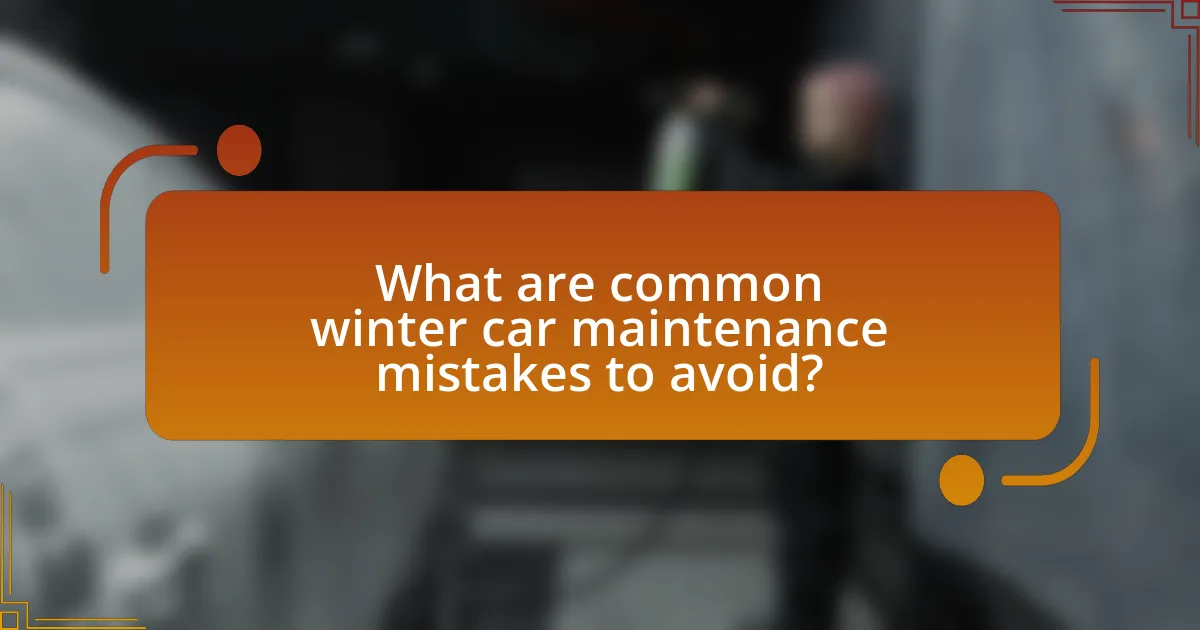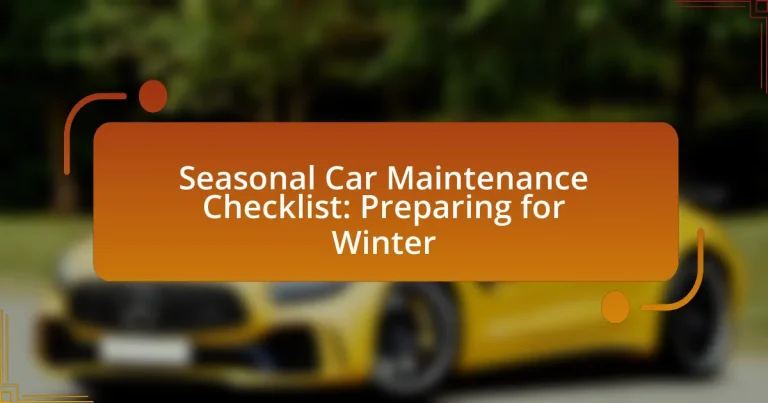The article focuses on a Seasonal Car Maintenance Checklist specifically designed for winter, emphasizing the importance of vehicle safety and performance during cold weather. It outlines essential maintenance tasks such as checking and replacing engine oil, inspecting the battery, ensuring adequate antifreeze levels, examining tire tread and pressure, testing brakes, and verifying the functionality of lights and wipers. Additionally, the article discusses the challenges winter poses for vehicles, the significance of proper maintenance to prevent issues, and the specific fluids and tire considerations necessary for safe winter driving. It also highlights common mistakes to avoid and best practices for vehicle preparation and storage during winter months.

What is a Seasonal Car Maintenance Checklist for Winter?
A Seasonal Car Maintenance Checklist for Winter includes essential tasks to ensure vehicle safety and performance during cold weather. Key items on the checklist are: checking and replacing the engine oil with winter-grade oil, inspecting the battery for charge and corrosion, ensuring the antifreeze levels are adequate, examining the tires for tread depth and proper inflation, testing the brakes, and verifying that all lights are functioning. Additionally, it is important to check the windshield wipers and fluid, as well as the heating and defrosting systems. These actions help prevent breakdowns and enhance driving safety in winter conditions.
Why is winter car maintenance important?
Winter car maintenance is important because it ensures vehicle safety and reliability during harsh weather conditions. Cold temperatures can lead to battery failure, tire issues, and reduced visibility, all of which can compromise driving safety. For instance, according to the AAA, cold weather can reduce battery capacity by up to 60%, making regular battery checks essential. Additionally, maintaining proper tire pressure is crucial, as it can drop by about one PSI for every 10-degree Fahrenheit decrease in temperature, affecting traction and handling. Regular maintenance, including checking antifreeze levels and ensuring wiper blades are functional, helps prevent breakdowns and accidents, ultimately enhancing overall vehicle performance in winter conditions.
What specific challenges does winter pose for vehicles?
Winter poses specific challenges for vehicles, primarily due to cold temperatures, snow, ice, and reduced visibility. Cold temperatures can lead to battery failure, as batteries lose their capacity to hold a charge in frigid conditions. Snow and ice create hazardous driving conditions, increasing the risk of accidents and requiring vehicles to have appropriate tires for traction. Additionally, reduced visibility from snow accumulation on windshields and headlights can impair a driver’s ability to see and be seen, further complicating safe driving. These factors necessitate thorough winter vehicle maintenance, including battery checks, tire inspections, and ensuring that wiper blades and lights are functioning properly.
How can proper maintenance prevent winter-related issues?
Proper maintenance can prevent winter-related issues by ensuring that a vehicle’s critical systems are functioning optimally in cold conditions. Regular checks on the battery, antifreeze levels, tire tread, and wiper blades can significantly reduce the risk of breakdowns and enhance safety. For instance, a fully charged battery is less likely to fail in low temperatures, as studies show that battery capacity decreases by about 20% at 32°F and can drop even further in colder conditions. Additionally, maintaining proper tire pressure and tread depth is crucial, as under-inflated tires can lose traction on icy roads, leading to accidents. Regularly replacing wiper blades ensures clear visibility during winter storms, which is essential for safe driving.
What are the key components of a winter maintenance checklist?
The key components of a winter maintenance checklist include checking the battery, inspecting the tires, testing the antifreeze, examining the wiper blades, and ensuring the heating system is functional. A fully charged battery is crucial as cold weather can reduce battery capacity significantly, often by up to 50%. Proper tire tread depth and pressure are essential for traction on icy roads; tires should have at least 4/32 of an inch tread. Antifreeze levels must be adequate to prevent engine freezing, with a typical mix of 50% antifreeze and 50% water recommended. Wiper blades should be in good condition to ensure visibility during winter storms, and the heating system must be operational to maintain comfort and safety while driving.
Which fluids should be checked and replaced?
The fluids that should be checked and replaced include engine oil, coolant, brake fluid, transmission fluid, power steering fluid, and windshield washer fluid. Regularly checking these fluids ensures optimal vehicle performance and safety, especially during winter conditions. For instance, engine oil lubricates moving parts, while coolant prevents overheating; both are crucial for maintaining engine efficiency. Additionally, brake fluid is essential for effective braking, and transmission fluid ensures smooth gear shifts. According to the Car Care Council, neglecting these fluids can lead to severe vehicle issues, emphasizing the importance of regular maintenance.
What tire considerations are essential for winter driving?
Essential tire considerations for winter driving include using winter tires, ensuring proper tire pressure, and checking tread depth. Winter tires are specifically designed with rubber compounds that remain flexible in cold temperatures, providing better traction on snow and ice. Maintaining proper tire pressure is crucial, as cold weather can reduce tire pressure by about 1 psi for every 10°F drop in temperature, which can affect handling and safety. Additionally, a minimum tread depth of 6/32 inches is recommended for winter tires to ensure adequate grip; studies show that tires with insufficient tread can significantly increase stopping distances on icy roads.
How can drivers prepare their vehicles for winter conditions?
Drivers can prepare their vehicles for winter conditions by ensuring their tires are suitable for cold weather, checking the battery, and inspecting the vehicle’s fluids. Proper winter tires provide better traction on snow and ice, as they are designed with deeper treads and softer rubber compounds that remain flexible in low temperatures. A fully charged battery is crucial, as cold weather can reduce battery capacity; statistics show that battery failures increase by 20% in winter months. Additionally, checking antifreeze levels, windshield wiper fluid, and oil ensures that the vehicle operates efficiently in harsh conditions, as these fluids can thicken or freeze in cold temperatures.
What tools and supplies are necessary for winter maintenance?
Essential tools and supplies for winter maintenance include a snow shovel, ice scraper, windshield washer fluid, and tire chains. A snow shovel is necessary for clearing snow from driveways and walkways, while an ice scraper helps remove ice from vehicle windows for safe driving. Windshield washer fluid with antifreeze properties is crucial for maintaining visibility in winter conditions, and tire chains provide additional traction on icy roads. These items are commonly recommended by automotive experts to ensure safe and effective winter vehicle operation.
How often should maintenance checks be performed during winter?
Maintenance checks should be performed at least once a month during winter. This frequency ensures that critical components such as the battery, tires, and fluids are in optimal condition to handle cold weather conditions. According to the American Automobile Association (AAA), regular checks can prevent breakdowns and enhance vehicle safety during winter months, where harsh conditions can exacerbate existing issues.

What specific tasks should be included in the winter maintenance checklist?
The winter maintenance checklist for vehicles should include tasks such as checking and replacing antifreeze, inspecting the battery, testing tire tread depth, ensuring proper tire pressure, and verifying that windshield wipers and fluid are functioning effectively. These tasks are essential for optimal vehicle performance in cold weather conditions. For instance, antifreeze prevents engine freezing, while a well-functioning battery is crucial as cold temperatures can reduce battery capacity by up to 50%. Additionally, maintaining proper tire pressure is vital, as it can drop by about 1 PSI for every 10°F decrease in temperature, impacting traction and safety.
How do you check and maintain battery health in winter?
To check and maintain battery health in winter, regularly inspect the battery for corrosion, ensure connections are tight, and test the battery’s voltage. Cold temperatures can reduce battery capacity, so it’s essential to keep the battery fully charged; a fully charged battery can withstand cold better than a partially charged one. Additionally, using a battery maintainer can help keep the battery charged during periods of inactivity. According to the Battery Council International, a battery’s performance can drop by up to 60% in cold weather, highlighting the importance of these maintenance practices.
What signs indicate a weak battery?
Signs that indicate a weak battery include slow engine cranking, dim headlights, and electrical issues such as malfunctioning power windows or dashboard lights. These symptoms occur because a weak battery struggles to provide sufficient power to start the engine and operate electrical components effectively. For instance, a study by the Battery Council International states that batteries typically last three to five years, and performance declines as they age, leading to these observable signs.
How can you extend battery life during cold months?
To extend battery life during cold months, keep the battery fully charged and maintain it at a stable temperature. Cold temperatures can reduce a battery’s capacity by up to 50%, so regularly checking the charge level and using a battery maintainer can help. Additionally, parking the vehicle in a garage or using a battery blanket can protect the battery from extreme cold, further enhancing its performance and longevity.
What steps should be taken to ensure proper tire performance?
To ensure proper tire performance, regularly check tire pressure, tread depth, and alignment. Maintaining the correct tire pressure is crucial, as under-inflated tires can reduce fuel efficiency and increase wear, while over-inflated tires can lead to blowouts. The recommended tire pressure for most vehicles is typically found on a sticker inside the driver’s door or in the owner’s manual.
Tread depth should be monitored using the penny test; if a penny inserted into the tread shows the top of Lincoln’s head, the tires need replacement. Proper tread depth is essential for optimal traction, especially in winter conditions. Additionally, having the vehicle’s alignment checked ensures that tires wear evenly and improves handling, which is particularly important during winter driving when road conditions can be unpredictable.
Regularly rotating tires every 5,000 to 7,500 miles also promotes even wear and extends tire life. Following these steps will enhance tire performance and safety during winter driving.
How do you assess tire tread depth for winter safety?
To assess tire tread depth for winter safety, use a tread depth gauge or the penny test. A tread depth gauge provides an accurate measurement, while the penny test involves inserting a penny into the tread with Lincoln’s head facing down; if you can see the top of Lincoln’s head, the tread is too shallow for safe winter driving. For optimal winter performance, tire tread should be at least 6/32 of an inch deep, as studies show that tires with insufficient tread can significantly reduce traction on snow and ice, increasing the risk of accidents.
What is the importance of tire pressure in cold weather?
Tire pressure is crucial in cold weather because lower temperatures cause air to contract, leading to decreased tire pressure. Maintaining proper tire pressure enhances vehicle safety, improves fuel efficiency, and ensures optimal tire performance. According to the U.S. Department of Energy, for every 10°F drop in temperature, tire pressure can decrease by about 1 PSI. This reduction can lead to increased tire wear and reduced traction, making it essential to regularly check and adjust tire pressure during colder months.
How can you prepare your vehicle’s fluids for winter?
To prepare your vehicle’s fluids for winter, you should check and replace the engine oil, coolant, windshield washer fluid, and brake fluid as necessary. Engine oil should be changed to a winter-grade oil that flows better in cold temperatures, ensuring optimal engine performance. The coolant must be tested for freeze protection and replaced if it does not meet the required standards, typically a 50/50 mix of antifreeze and water. Windshield washer fluid should be filled with a winter formula that prevents freezing, while brake fluid should be inspected for moisture content and replaced if it is contaminated. These actions help maintain vehicle performance and safety during winter conditions.
What types of antifreeze are recommended for winter use?
Ethylene glycol and propylene glycol are the two main types of antifreeze recommended for winter use. Ethylene glycol is commonly used due to its effective freezing point depression and heat transfer properties, making it suitable for most vehicles. Propylene glycol is a safer alternative, often recommended for use in vehicles that may be around pets or children, as it is less toxic. Both types are formulated to prevent freezing and protect the engine from corrosion during cold weather, ensuring optimal performance in winter conditions.
How do you check and maintain windshield washer fluid levels?
To check and maintain windshield washer fluid levels, locate the windshield washer fluid reservoir, which is typically marked with a windshield symbol. Open the reservoir cap and visually inspect the fluid level; it should be between the minimum and maximum indicators. If the fluid is low, refill it with a suitable windshield washer fluid, ensuring it is appropriate for winter conditions to prevent freezing. Regular checks, especially before winter, are essential as low fluid levels can impair visibility during adverse weather.

What are common winter car maintenance mistakes to avoid?
Common winter car maintenance mistakes to avoid include neglecting tire maintenance, failing to check antifreeze levels, and overlooking battery health. Neglecting tire maintenance can lead to reduced traction and increased risk of accidents; studies show that winter tires improve safety by 35% in snowy conditions. Failing to check antifreeze levels can result in engine overheating or freezing, as proper coolant levels are crucial for temperature regulation. Overlooking battery health is critical, as cold temperatures can reduce battery capacity by up to 50%, leading to starting issues. Addressing these common mistakes ensures better vehicle performance and safety during winter months.
Why is neglecting tire maintenance a critical error?
Neglecting tire maintenance is a critical error because it significantly increases the risk of tire failure, which can lead to accidents. Proper tire maintenance, including regular inspections, inflation checks, and tread depth assessments, ensures optimal performance and safety, especially in winter conditions where traction is essential. According to the National Highway Traffic Safety Administration, under-inflated tires can reduce fuel efficiency by up to 3% and increase the likelihood of blowouts, particularly in cold weather when tire pressure decreases. Therefore, maintaining tires is essential for vehicle safety and efficiency, particularly during winter driving.
What are the consequences of driving on worn tires in winter?
Driving on worn tires in winter significantly increases the risk of accidents due to reduced traction and longer stopping distances. Worn tires have less tread depth, which compromises their ability to grip icy or snowy roads, leading to a higher likelihood of skidding or losing control. According to the National Highway Traffic Safety Administration, tires with insufficient tread can increase stopping distances by up to 30% on wet or icy surfaces. Additionally, worn tires are more susceptible to punctures and blowouts, which can be particularly dangerous in winter conditions where road hazards are more prevalent.
How can improper fluid levels affect vehicle performance?
Improper fluid levels can significantly impair vehicle performance by causing overheating, reduced lubrication, and compromised braking efficiency. For instance, low engine oil levels can lead to increased friction and wear on engine components, potentially resulting in engine failure. Similarly, insufficient coolant can cause the engine to overheat, which may lead to severe damage. Additionally, inadequate brake fluid can reduce braking effectiveness, increasing stopping distances and posing safety risks. These issues highlight the critical importance of maintaining proper fluid levels to ensure optimal vehicle operation and safety, especially during winter conditions when performance is crucial.
What should you avoid when preparing your vehicle for winter?
When preparing your vehicle for winter, you should avoid neglecting essential maintenance tasks. Failing to check and replace worn tires can lead to decreased traction on icy roads, increasing the risk of accidents. Additionally, overlooking the battery’s condition may result in a dead battery during cold weather, as batteries lose efficiency in low temperatures. Not inspecting the antifreeze levels can cause engine overheating or freezing, leading to costly repairs. Lastly, ignoring the importance of windshield wipers and fluid can impair visibility during winter storms, compromising safety. These actions are critical to ensure your vehicle operates safely and efficiently throughout the winter months.
How can overloading your vehicle impact winter driving safety?
Overloading your vehicle significantly compromises winter driving safety by increasing the risk of loss of control and longer stopping distances. When a vehicle exceeds its weight limit, it can lead to reduced traction on icy or snowy roads, making it harder for tires to grip the surface. Additionally, the added weight affects braking performance, as heavier vehicles require more distance to stop, which is critical in winter conditions where stopping quickly can prevent accidents. Studies indicate that vehicles carrying loads beyond their recommended capacity are more prone to skidding and hydroplaning, particularly on slick surfaces.
What are the risks of ignoring warning lights on the dashboard?
Ignoring warning lights on the dashboard poses significant risks, including potential engine damage, compromised safety, and increased repair costs. When warning lights illuminate, they indicate issues that require immediate attention; for example, a check engine light may signal a malfunction that could lead to engine failure if neglected. According to the National Highway Traffic Safety Administration, ignoring dashboard warnings can result in accidents due to undetected mechanical failures, such as brake or tire issues. Additionally, unresolved problems often escalate, leading to more extensive repairs that could have been avoided with timely intervention.
What practical tips can help ensure effective winter car maintenance?
To ensure effective winter car maintenance, regularly check and replace fluids, including antifreeze, oil, and windshield washer fluid, as these are crucial for optimal vehicle performance in cold conditions. Antifreeze prevents engine freezing, while proper oil viscosity ensures smooth engine operation in low temperatures. Additionally, inspect and maintain tire pressure and tread depth, as cold weather can reduce tire pressure and affect traction. According to the National Highway Traffic Safety Administration, maintaining proper tire pressure can improve fuel efficiency and enhance safety. Furthermore, ensure that the battery is in good condition, as cold weather can reduce battery capacity; a fully charged battery is essential for reliable starts. Regularly checking wiper blades and headlights also enhances visibility during winter storms, contributing to safer driving conditions.
How can regular inspections improve vehicle reliability in winter?
Regular inspections enhance vehicle reliability in winter by identifying and addressing potential issues before they lead to breakdowns. These inspections typically include checking critical components such as the battery, tires, brakes, and fluid levels, which are crucial for safe operation in cold conditions. For instance, a study by the American Automobile Association (AAA) found that 30% of drivers do not properly maintain their vehicles, leading to increased risks during winter months. By ensuring that these elements are functioning optimally, regular inspections can prevent failures that are more likely to occur in harsh weather, thereby improving overall vehicle performance and safety.
What are the best practices for storing a vehicle during winter months?
The best practices for storing a vehicle during winter months include cleaning the vehicle thoroughly, ensuring proper fluid levels, and using a car cover. Cleaning the vehicle prevents corrosion from road salt and grime, while checking fluid levels, including antifreeze and oil, ensures optimal performance. Additionally, using a breathable car cover protects the vehicle from moisture and debris. These practices are supported by automotive experts who recommend thorough preparation to extend the vehicle’s lifespan and maintain its condition during harsh winter conditions.


